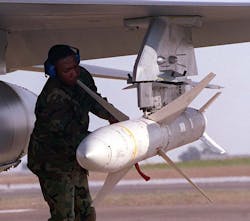Raytheon completes tests of the HARM control section modification upgrade
As part of the Air Force competition, Raytheon completed two flight tests of HCSM-modified HARMs. During an April 12, 2012, test, an F-16 aircraft fired a HCSM variant against an emitter that shut down, while a similar threat outside the designated missile impact zone threatened to lure the missile off target. The missile rejected the lure and was guided to its primary target. During a May 3 test, an HCSM-enhanced HARM that was fired from an F-16 used GPS coordinates to engage with a simulated time-critical target.
The AGM-88 HARM is used to suppress or destroy surface-to-air missile radars, early warning radars, and radar-directed air defense artillery systems. The missile is used by eight countries, and more than 4,000 have been used to date.
